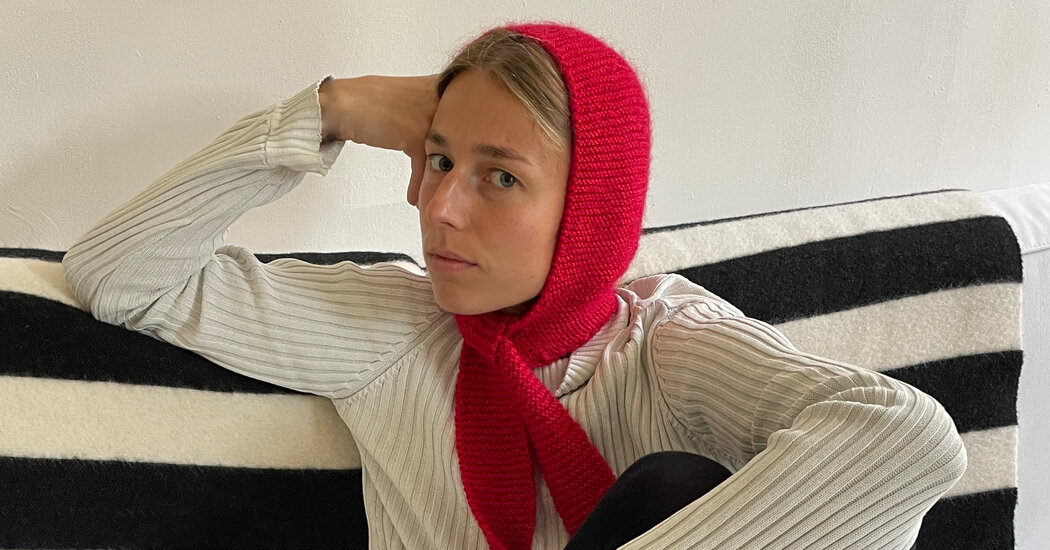Each winter, a specific cold-weather accessory, such as a rainbow plaid scarf, often defines the season. This year, that item turns out to be a knitted hat that you could describe as a baby hat for adults. It is also reminiscent of a balaclava, leading some sellers to call it the “balabonnet.”
The accessory, which has been embraced by a certain group of fashionable women, comes in different interpretations, ranging from girlie to monastic. Many styles can be tied under the chin to create a streamlined egg shape, and some have longer straps that can be wrapped around the neck like a scarf for a full snood look.
There are hats decorated with sterling silver rings, such as the version of Gemzona brand in New York City. Mimi Wade, a label from Los Angeles, makes a cute one style with pointed cat ears. The hats are also sold at chain stores such as Free People and Hot Topic; the latter offers one hood covered in little pink bows.
A $210 version from Pien Studios, a four-year-old label in Amsterdam, has become one of the most coveted. The fluffy hat, which the brand calls a balaclava, is made from a blend of mohair, merino wool and silk and has thin, scarf-like bands. It is produced in a handful of colors and sold in trendy boutiques around the world, including Amomento in Seoul, Esmeralda Serviced Department in Tokyo and Carmen in Amsterdam.
Grace Hwang, a creative director of advertising in Brooklyn, bought a Pien Studios hat last year at Tangerine, a multi-brand store in Williamsburg. Ms. Hwang, 33, said she has seen women in New York City wearing hats with different designs, and called her Pien Studios version the most versatile winter accessory she owns. (She prefers to call it a beanie-scarf, not a hat.)
The Pien Studios hat has an oval shape that, according to Pien Barendregt, the label’s founder, is inspired by that of space-age style hats from the 1960s. Ms Barendregt, 30, added that she aimed for a silhouette that looked feminine compared to bulkier winter clothes. “It looks very elegant if you have a super large coat; it balances it out nicely,” she said.
Although the label calls the hat a balaclava, Ms Barendregt agreed it was more of a beanie and said she had received requests to make children’s versions. When she introduced the style two and a half years ago, many women described it as nostalgic, she said, adding that hats are practical accessories for the cold, damp winters in Amsterdam, where she lives, because they envelop the head like a hood.
Ms. Barendregt used to knit each hat herself, she says, but she recently outsourced production to fulfill the hundreds of orders she received this winter.
Lau Frías, 30, bought a white hat from Pien Studios in October at Bomi, a boutique in Manhattan’s SoHo district. “It feels like an elevated version of the many hoods out there,” said Ms. Frías, who works in music and lives in Brooklyn. She sees the growing interest in the accessory as an indication that women are not dressing to be noticed by men, but are instead “thinking about looking cute because of the female gaze,” she said.
Although there is a wide selection of hats available in stores, people also knit their own hats. Several pattern makers have released DIY templates, including PetiteKnit, a Danish company popular with younger knitters, which sells the pattern for its Sophie Hood — a hat-scarf hybrid — for 35 Danish kroner, or about $5. An Instagram account video Showing a completed version of the hat has been viewed more than 16 million times since it was published in late December.
PetiteKnit founder Mette Okkels, 35, said the hood is a bit sloppily designed because she thinks tight-fitting hats are too similar to infant versions. “I’m not ready for that yet,” she said.
Recently, at the weekly knitting events hosted by Knit Club, a yarn store in Providence, RI, a majority of attendees arrived wearing hats of their own creation, said Lindsay Degen, the store’s owner.
“And it’s not always the same people,” added Ms. Degen, who is also a knitwear designer. “It’s a huge thing.”
The ethics behind our store reporting. When Times reporters write about products, they never accept merchandise, money or favors from the brands. We do not earn any commission on purchases made through this article.





